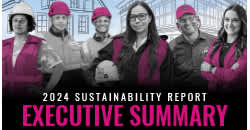At Owens Corning, we recognize that climate change is real, and human activity is a primary cause. As temperatures around the world continue to climb as a result of greenhouse gas (GHG) emissions, we understand the importance of taking corrective actions across our operations.
That’s why we’ve set ambitious goals designed to dramatically reduce our GHG emissions by 2030. We’ve established short-term and long-term strategies to help us reduce our Scope 1 and Scope 2 emissions by 50%.
Learn More


